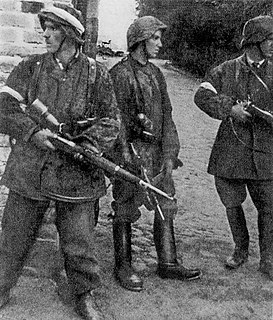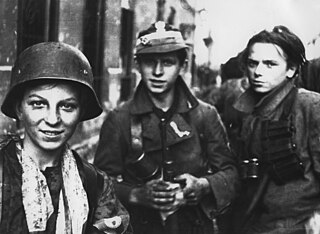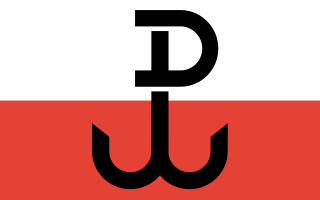 W
WThe anti-communist resistance in Poland, also referred to as the Polish anti-Communist insurrection fought between 1944 and 1953, was an armed struggle by the Polish Underground against the Soviet takeover of Poland at the end of World War II in Europe. The guerrilla warfare conducted by the resistance movement formed during the war, included an array of military attacks launched against Communist prisons, state security offices, detention facilities for political prisoners, and prison camps set up across the country by the Stalinist authorities.
 W
WArmia Ludowa was a communist Soviet-backed partisan force set up by the communist Polish Workers' Party (PPR) during World War II. It was created on the order of the Polish State National Council on 1 January 1944. Its aims were to fight against Nazi Germany in occupied Poland, support the Soviet Red Army against the German forces and aid in the creation of a pro-Soviet communist government in Poland.
 W
WBataliony Chłopskie was a Polish World War II resistance movement, guerrilla and partisan organisation. The organisation was created in mid-1940 by the agrarian political party People's Party and by 1944 was partially integrated with the Armia Krajowa. At its height, in summer 1944 the organisation had 160,000 members.
 W
WCichociemni were elite special-operations paratroopers of the Polish Army in exile, created in Great Britain during World War II to operate in occupied Poland.
 W
WWorld War II saw the cultivation of underground education in Poland. Secretly conducted education prepared scholars and workers for the postwar reconstruction of Poland and countered German and Soviet threats to eradicate Polish culture.
 W
W"Gray Ranks" was a codename for the underground paramilitary Polish Scouting Association during World War II.
 W
WGwardia Ludowa or GL was a communist underground armed organization created by the communist Polish Workers' Party in German occupied Poland, with sponsorship from the Soviet Union. Formed in early 1942, within a short time Gwardia Ludowa became the largest clandestine fighting force on Polish soil which refused to join the structures of the Polish Underground State loyal to the London-based government-in-exile. In the January 1 of 1944 GL was incorporated into the communist Armia Ludowa.
 W
WThe Home Army was the dominant resistance movement in German-occupied Poland during World War II. The Home Army was formed in February 1942 from the earlier Związek Walki Zbrojnej established in the aftermath of the German and Soviet invasions in September 1939. Over the next two years, the Home Army absorbed most of the other Polish partisans and underground forces. Its allegiance was to the Polish government-in-exile in London, and it constituted the armed wing of what came to be known as the Polish Underground State.
 W
WThe Ivanhorod Einsatzgruppen photograph is an image of the Holocaust, showing a soldier aiming a rifle at a woman who is trying to shield a child with her body. It depicts the murder of Jews by an Einsatzgruppen death squad near Ivanhorod, Ukraine, in 1942. The photograph was mailed, intercepted by the Polish resistance in Warsaw, and kept by Jerzy Tomaszewski. In the 1960s, it was alleged that the image was a Communist forgery, but that claim was eventually falsified. Since then, the photograph has been frequently used in books, museums, and exhibitions relating to the Holocaust. Photograph historian Janina Struk describes it as "a symbol of the barbarity of the Nazi regime and their industrial scale murder of 6 million European Jews."
 W
WThe Jewish Combat Organization was a World War II resistance movement in occupied Poland, which was instrumental in organizing and launching the Warsaw Ghetto Uprising. ŻOB took part in a number of other resistance activities as well.
 W
WŻydowski Związek Wojskowy was an underground resistance organization operating during World War II in the area of the Warsaw Ghetto, which fought during the Warsaw Ghetto Uprising and 1944 Warsaw Uprising. It was formed, primarily of former officers of the Polish Army, in late 1939, soon after the start of the German occupation of Poland.
 W
WLeśni ludzie is an informal name applied to some anti-German partisan groups that operated in occupied Poland during World War II, being a part of Polish resistance movement.
 W
WA minor sabotage during World War II in Nazi-occupied Poland (1939–45) was any underground resistance operation that involved a disruptive but relatively minor and non-violent form of defiance, such as the painting of graffiti, the manufacture of fake documents, the disrupting of German propaganda campaigns, and the like. Minor-sabotage operations often involved elements of humor.
 W
WNational Armed Forces was a Polish right-wing underground military organization of the National Democracy operating from 1942. During World War II, NSZ troops fought against Nazi Germany and communist partisans. There were also cases of fights with the Home Army.
 W
WNarodowa Organizacja Wojskowa was one of the Polish resistance movements in World War II. Created in October 1939, it did not merge with the Service for Poland's Victory (SZP)/Union of Armed Struggle (ZWZ); later Home Army (AK). Nevertheless, it recognized the Polish government in exile, which was located in London. The National Military Organization was politically related to the National Party (SN). In 1942/1943 it split into two parts; one merged with the Home Army, while another formed the National Armed Forces (NSZ). After the Warsaw Uprising, most of NOW members formed the National Military Union (NZW).
 W
WThe organization of underground resistance movements in Auschwitz concentration camp began in the second half of 1940, shortly after the camp became operational in May that year. In September 1940 Witold Pilecki, a Polish army captain, arrived in the camp. Using the name Tomasz Serafiński, Pilecki had allowed himself to be captured by Germans in a street round up (łapanka) with the goal of having himself sent to Auschwitz to gather information and organize resistance inside. Under Pilecki's direction the Związek Organizacji Wojskowej, ZOW, was formed.
 W
WSecret Military Organization, or Tajna Organizacja Wojskowa, TOW in Polish, was a clandestine military formation organized prior to World War II in the Second Polish Republic in the event Polish territory was occupied by foreign powers. The country-wide TOW organization was active in the early days of the September 1939 Campaign and during the Nazi occupation of Poland. Some of the offshoots or independently organized local "TOWs", such as Tajna Organizacja Wojskowa Gryf Pomorski or Tajna Organizacja Wojskowa Gryf Kaszubski were active throughout the whole period of the German occupation as well as the early years of the Soviet takeover.
 W
WThe Tatra Confederation, or Confederation of the Tatra Mountains, was a Polish resistance organization operating in the southernmost Podhale region during the Nazi German occupation of Poland. The Tatra Confederation was founded in May 1941 in Nowy Targ – the historical capital of Podhale, by the poet and partisan, Augustyn Suski ; with Tadeusz Popek as his deputy. The organization had its ideological roots in the peasant movement of the mountain region of interwar Poland.